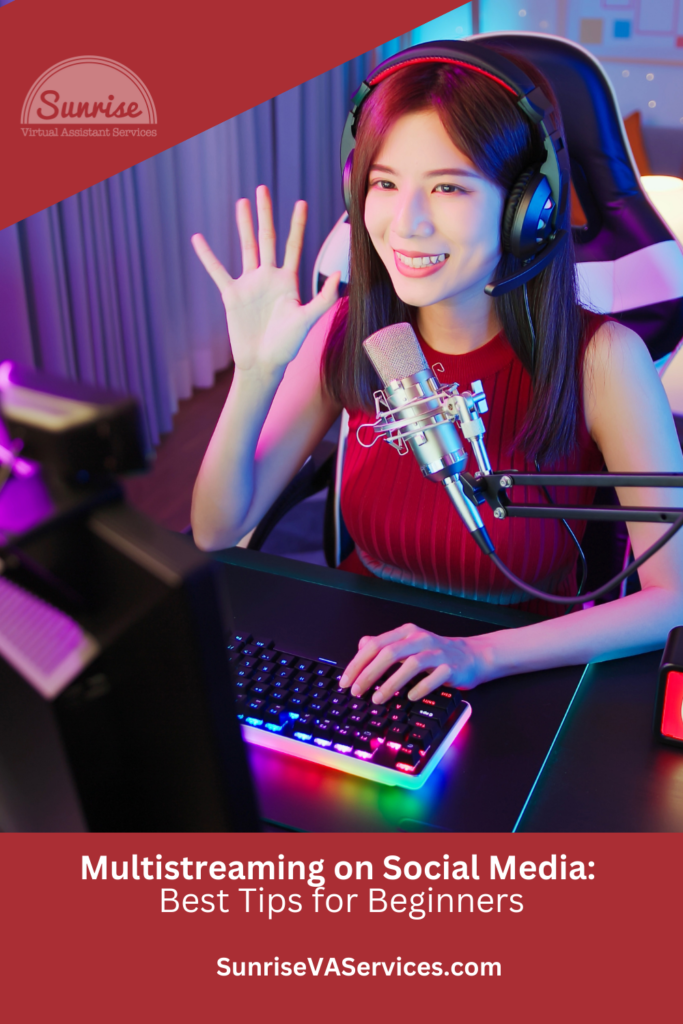Content creators are always seeking ways to expand their reach and engage with larger audiences. One powerful strategy that has started to gain significant traction lately is multistreaming.
This technique lets you broadcast your content across multiple social media platforms, maximizing your visibility and impact.
If you’re new to multistreaming, we’ll walk you through the basics and provide valuable tips to get you started.
Why Multistreaming Matters
Live streaming isn’t losing momentum anytime soon. But before diving into the how-to’s, let’s explore why multistreaming is now a game-changer for content creators:
- Maximize Reach: You can tap into diverse audience pools by streaming to multiple platforms simultaneously, significantly expanding your potential viewership.
- Cost-Efficiency: Multistreaming saves both time and resources. Instead of creating separate content for each platform, you can broadcast once and reach all your channels.
- Audience Diversification: Different social media platforms attract varied demographics. Multistreaming allows you to engage with a more diverse audience, potentially attracting new followers and expanding your community.
- Consistent Branding: Maintaining a unified presence across all online venues becomes easier with multistreaming, reinforcing your brand identity.
- Enhanced Engagement: Real-time interaction with followers from different platforms can lead to more dynamic and engaging streams.
Getting Started with Multistreaming
- Choose Your Platforms
Start by identifying which platforms align best with your content and target audience. Popular options include:
Remember, focusing on a few platforms where your audience is most active is better than trying to be everywhere at once!
- Select a Multistreaming Tool
To broadcast to multiple platforms simultaneously, you’ll need a multistreaming tool. Some popular options include:
Research these tools to find one that fits your needs and budget. Many offer free trials, allowing you to test their features before committing.
- Set Up Your Equipment
Ensure you have the necessary equipment for high-quality streams:
- A reliable computer or mobile device
- Stable internet connection (wired is preferable)
- Quality camera (built-in or external)
- Good microphone
- Proper lighting
- Plan Your Content
While spontaneity can be great, having a content plan helps ensure smooth, engaging streams.
Consider:
- Topics or themes for each stream
- Guest speakers or collaborators
- Interactive elements (Q&A sessions, polls, etc.)
- Visual aids or props
- Optimize for Each Platform
Although you’re streaming to multiple platforms, it’s crucial to optimize your content for each:
- Use appropriate hashtags for each platform
- Adjust your stream title and description to fit platform-specific best practices
- Be aware of different aspect ratios (e.g., vertical for mobile-first platforms like TikTok)
Best Practices for Successful Multistreaming
- Engage Across Platforms: Acknowledge and interact with viewers from all platforms. Consider having a moderator to help manage comments and questions.
- Maintain Consistent Quality: Ensure your audio and video quality remain high across all platforms. Test your setup before going live.
- Promote in Advance: Let your followers on each platform know when and where you’ll be streaming.
- Use Platform-Specific Features: Leverage unique features of each platform (e.g., Twitch emotes, YouTube Super Chat) to enhance engagement.
- Monitor Analytics: Track your performance across platforms to understand where your content resonates most and adjust your strategy accordingly.
- Be Authentic: While it’s important to optimize for each platform, maintain your authentic voice and style across all channels. Do you have anxiety? Check out these tips!
- Follow Platform Guidelines: Ensure you’re adhering to the terms of service and community guidelines for each specific platform you’re streaming to. What could be allowed to be done or said on one platform, isn’t always the case on another.
Overcoming Common Multistreaming Challenges
- Technical Issues: Always have a backup plan. If one platform experiences issues, be prepared to direct viewers to another.
- Audience Segmentation: Use inclusive language that doesn’t alienate viewers on any particular platform.
- Content Relevance: Make sure your content is niche relevant and valuable to audiences across all platforms you’re streaming to.
- Bandwidth Limitations: If your internet can’t handle multiple high-quality streams, consider reducing quality on some platforms or focusing on fewer platforms.
Conclusion
Multistreaming offers an exciting opportunity for content creators to find and engage with new audiences. By choosing the right platforms and tools, optimizing your creative content, and following best practices, you can absolutely leverage this strategy to grow your online presence.
Remember, successful multistreaming is about more than broadcasting to multiple platforms—it’s about creating meaningful connections with your audience, wherever they may be. Start small, experiment with different approaches, and continually refine your live streaming strategy based on feedback and analytics.
As you embark on your multistreaming journey, stay patient and persistent. Building an audience takes time, but with consistent, quality content and genuine engagement, you’ll be well on your way to multistreaming success.
Need help developing a content strategy? That’s where Sunrise Virtual Assistant Services can give you the boost you need for a running start! Contact us today, and let’s design a content strategy that works for you!


